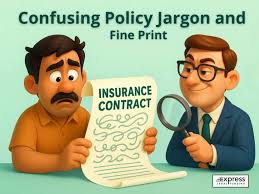
Understanding Insurance Jargon – The Real Meaning Behind the Fine Print
Ever felt like your insurance policy was written in a foreign language?
You’re not alone.
Insurance contracts are packed with technical terms and legal jargon that can leave even the most educated policyholders confused. But here’s the truth: that fine print isn’t just boring—it can cost you money, coverage, and peace of mind if you don’t understand it.
Let’s decode the lingo, so you know exactly what you’re signing up for.
📃 Why the Fine Print Matters
Insurers rely on complex language to define what they’ll cover—and what they won’t. If you misunderstand even one clause, you might end up underinsured, overpaying, or denied in a crisis.
Reading your policy doesn’t have to be overwhelming. Here’s what you need to look out for:
🧠 Key Insurance Terms, Demystified
1. Premium
This is the amount you pay—monthly, quarterly, or annually—to keep your policy active.
Think of it as your subscription fee. No payment = no coverage.
2. Deductible
The amount you pay out of pocket before insurance kicks in.
Example: If your deductible is $1,000 and you have $5,000 in damage, the insurer pays $4,000.
3. Coverage Limit
The maximum your policy will pay for a covered loss.
Tip: Make sure your limit reflects the actual cost to replace your home, car, or belongings—not just their current value.
4. Exclusion
These are situations or damages not covered by your policy.
Common exclusions include floods, earthquakes, and wear-and-tear. If you don’t see it covered—assume it’s not.
5. Rider or Endorsement
This is extra coverage added to a standard policy—for things like jewelry, fine art, or home businesses.
If your valuables aren’t specifically listed, they may not be protected.
6. Actual Cash Value (ACV) vs. Replacement Cost
-
ACV pays based on the item’s depreciated value.
-
Replacement Cost pays the full cost to replace it new.
Always check which one your policy offers—it makes a huge difference in a claim.
🧾 Tricks Hidden in the Fine Print
⚠️ “Acts of God”
Some policies exclude natural disasters like floods or wildfires—unless you have special coverage. Always ask what’s considered an act of God under your plan.
🕒 Time Limits for Filing Claims
Many policies have tight deadlines for reporting damage—sometimes just 48–72 hours. Miss that window, and your claim could be denied.
🚪 Vacancy Clauses
If your home is left empty for too long (usually over 30–60 days), your coverage could be voided—unless you have a special rider.
🔍 How to Read a Policy Like a Pro
-
Start with the Declarations Page
This “cheat sheet” lists your premiums, coverage types, limits, and deductible amounts. -
Highlight Key Sections
Focus on Exclusions, Coverage Limits, and Conditions. -
Ask for a Plain-English Summary
Many insurers offer simplified versions of the policy—don’t be afraid to request one. -
Consult an Expert
Insurance agents, brokers, or independent advisors can walk you through anything you don’t understand.
🧠 Final Thought
Insurance is meant to protect you, not confuse you. But if you don’t understand the fine print, you could be leaving yourself vulnerable when it matters most.
By learning the lingo and knowing what to look for, you take back control—and ensure you’re truly covered.